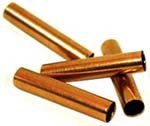|
|

 Corbin Bullet Jackets are packaged in bags of either 100, 250
or 500, depending on their size and weight.
Corbin Bullet Jackets are packaged in bags of either 100, 250
or 500, depending on their size and weight.
There are three sub-categories under jackets:
- Rifle jackets
- Pistol jackets
- Base Guards
Rifle jackets are typically longer and have heavier walls and bases than pistol jackets. Rifle calibers of 224, 243, 264, 308, 406, 510 and 720 can all be drawn down with a reducing diek (not "swaged" which goes "UP"). The sizes not usually offered are produced from the next larger size and a JRD-1 draw die, sometimes trimmed with an ET-2 trim die.
Pistol (handgun) jackets are typically shorter, thinner walled, and made for handgun calibers. However, there is some overlap. The larger calibers can also be used
for light and medium weight bullets in some rifles. Many handgun jackets can be redrawn through a Corbin JRD-1- draw die to make longer, smaller calibers that could in fact
be rifle calibers such as the .351 Self Loader made from a .38/9mm jacket redrawn. The .30 Carbine can be made in re-drawn .38/9mm jackets (90-110 grain 30's). If you don't
see the jacket you want, ask about how it might be made from a larger caliber that is listed.
Base Guards(tm) are Corbin's trade-marked copper disks with a slightly conical shape and a hole at the apex, which swage onto the base of lead bullets and can be as effective as a half jacket at far lower cost. The BG disks present a fouling scraper edge to the bore, pushing leading and powder fouling out the barrel ahead of the disk, so the next bullet sees a cleaner bore. Gas checks can be made from copper strip using Corbin's GCM-1 gas check maker kits.
Bullet jackets
are made of copper and zinc, in 95-5 or 90-10 ratio. You can also make your own bullet jackets using pure copper strip, with Corbin's Jacket Maker Kits (JMK).
Select the category of jacket from the list at the left...

Why Bullet Jackets are a GOOD Value:
Bullet jackets are primarily made of copper. They have both utility value, to make various weights of bullets, and intrinsic value, for the metal. The price of both copper and bullet jackets has historically risen faster than inflation, sometimes by a considerable amount.
Unlike buying copper futures, usually measured in tons, you can buy however many jackets are comfortable for you to own now. Unlike futures contracts, you take delivery immediately. Then, if the copper market goes higher in the future, your
jackets are worth more than you paid, and you can sell some if you don't need them for
yourself.
If the price goes down in the future, no problem, you paid a reasonable price at the time and guaranteed your supply.
It doesn't hurt to hang on to the ones you have left, and wait for the price to go up again if you want to
sell some. If you don't tie up money that you might need quickly, it's a low risk investment.
Owning a good supply of bullet jackets at today's price
is not such a bad idea, if you shoot and make bullets anyway. Copper prices have historically cycled higher over time, often by quite a large amount. On a year to year basis, the price is more often higher in the future, even if there are monthly drops and
peaks along the way. So your bet that the jackets will be worth more in the future is likely to pay off.
And you will be holding something you can actually use, not merely paper. And that other bullet makers can buy from you in small increments, if you need to
get some of the money back at a future date, likely at a higher price (no guarantees, of course, but look at the price
history and judge for yourself).
Jackets have added value because they are not always easy to find on the market. Most jacket-producing sources don't particularly want to sell just
the jacket to a hand loader, because most of them use their own jackets to make bullets, and to load ammo, which sells
at far higher margins.
That's why, although jackets are being made by the millions, there are almost none to be found on the market in the majority of lengths and calibers. Selling small lots to handloaders is often more of a bother than it is worth to a large producer of bullets or ammo.
Having a thousand dollars in a savings account or CD today is going
to give you, what, maybe $30 gain in the next three years not even counting the inflation loss? Bullet jackets have gone up in value more than 500% in a time period when the dollar became worth about 50% its initial purchasing power. The increase in price has far
outpaced inflation, partly because of vastly increased use of copper in electrical products, and added increases in
labor and transportation costs to produce and bring the jackets to the end users.
Bullet jackets are durable and have
intrinsic metal value even if not used in bullet making. And you can buy whatever quantity you feel comfortable
owning! At least, you can now while they are available! It's worth considering!
Disclaimer: None of the above is intended to be professional investment advice. All opinions expressed are just
that, an expression of opinion.
Check the facts for yourself, such as the historical copper prices over the past 5, 10, 20 year period, as well
as the cost of labor and transportation (for turning the copper into jackets, and for moving the materials from
mine to mill to drawing plant to distributor and finally to you). Check the price of bullet jackets 5, 10, 20 years ago. Then check your bank's interest rates! Always seek professional advice from a licensed broker
or investment professional for advice on futures, commodities and stock purchases. Gotta say this, to soothe those with no sense
of humor or a totally literal mind-set.
|









Corbin Bullet Jackets are packaged in bags of either 100, 250 or 500, depending on their size and weight.


























